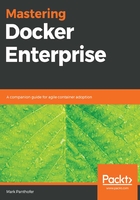
上QQ阅读APP看书,第一时间看更新
Overview of a sample PoC environment
Prepare a network with four fresh Linux nodes attached:
- Four nodes are connected to the same network, allowing all traffic/ports between nodes (please note traffic will be locked down in the pilot and production steps).
- There's a fresh install of Linux on at least two nodes (Linux required for UCP and DTR nodes):
- Two vCPUs/cores for each node
- 8 GB of RAM
- 32 GB of disk space
- A Docker Enterprise supported Linux distribution: CentOS, Oracle Linux, Red Hat Enterprise Linux, SUSE Linux Enterprise Server, Ubuntu, Microsoft Windows Server 2016, Microsoft Windows Server 1709, or Microsoft Windows Server 1803
- There's a fresh install of Linux or Windows on one or more worker nodes:
- Two vCPUs/cores for each node
- 8 GB of RAM
- 32 GB of disk space for Linux and 80 GB for Windows Server
- A Docker Enterprise supported Linux distribution: CentOS, Oracle Linux, Red Hat Enterprise Linux, SUSE Linux Enterprise Server, Ubuntu, Microsoft Windows Server 2016, Microsoft Windows Server 1709, or Microsoft Windows Server 1803
Figure 2 shows a working example in which we created four t2.large instances running AWS with two vCPUs and 8 GB of RAM. All have public and private IP addresses assigned to their NIC. All Linux boxes have 32 GB of disk space and the Windows worker has 80 GB of disk space:

Figure 2: Mixed-Node PoC Cluster
Here, the Docker nodes communicate with each other on the local private network using the 172.31.0.x address space. However, to access our nodes externally and install Docker, we want to be able to SSH directly for the PoC. Please note for our post-PoC setup, all external traffic will come through a firewall or load balancer, where the load balancer serves as a bastion/jump host to avoid exposing the nodes externally.